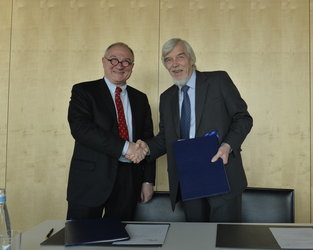Accept all cookies Accept only essential cookies See our Cookie Notice

About ESA
The European Space Agency (ESA) is Europe’s gateway to space. Its mission is to shape the development of Europe’s space capability and ensure that investment in space continues to deliver benefits to the citizens of Europe and the world.
Highlights
ESA - United space in Europe
This is ESA ESA facts Member States & Cooperating States Funding Director General Top management For Member State Delegations European vision European Space Policy ESA & EU Space Councils Responsibility & Sustainability Annual Report Calendar of meetings Corporate newsEstablishments & sites
ESA Headquarters ESA ESTEC ESA ESOC ESA ESRIN ESA EAC ESA ESAC Europe's Spaceport ESA ESEC ESA ECSAT Brussels Office Washington OfficeWorking with ESA
Business with ESA ESA Commercialisation Gateway Law at ESA Careers Cyber resilience at ESA IT at ESA Newsroom Partnerships Merchandising Licence Education Open Space Innovation Platform Integrity and Reporting Administrative Tribunal Health and SafetyMore about ESA
History ESA Historical Archives Exhibitions Publications Art & Culture ESA Merchandise Kids Diversity ESA Brand Centre ESA ChampionsLatest
Space in Member States
Find out more about space activities in our 23 Member States, and understand how ESA works together with their national agencies, institutions and organisations.
Science & Exploration
Exploring our Solar System and unlocking the secrets of the Universe
Go to topicAstronauts
Missions
Juice Euclid Webb Solar Orbiter BepiColombo Gaia ExoMars Cheops Exoplanet missions More missionsActivities
International Space Station Orion service module Gateway Concordia Caves & Pangaea BenefitsLatest
Space Safety
Protecting life and infrastructure on Earth and in orbit
Go to topicAsteroids
Asteroids and Planetary Defence Asteroid danger explained Flyeye telescope: asteroid detection Hera mission: asteroid deflection Near-Earth Object Coordination CentreSpace junk
About space debris Space debris by the numbers Space Environment Report In space refuelling, refurbishing and removingSafety from space
Clean Space ecodesign Zero Debris Technologies Space for Earth Supporting Sustainable DevelopmentLatest
Applications
Using space to benefit citizens and meet future challenges on Earth
Go to topicObserving the Earth
Observing the Earth Future EO Copernicus Meteorology Space for our climate Satellite missionsCommercialisation
ESA Commercialisation Gateway Open Space Innovation Platform Business Incubation ESA Space SolutionsLatest
Enabling & Support
Making space accessible and developing the technologies for the future
Go to topicBuilding missions
Space Engineering and Technology Test centre Laboratories Concurrent Design Facility Preparing for the future Shaping the Future Discovery and Preparation Advanced Concepts TeamSpace transportation
Space Transportation Ariane Vega Space Rider Future space transportation Boost! Europe's Spaceport Launches from Europe's Spaceport from 2012
AI chip testing at CERN
Thank you for liking
You have already liked this page, you can only like it once!
An ESA-led team test the suitability of Intel’s new Myriad 2 artificial intelligence chip to fly in space using a radiation beam at CERN, the European Organization for Nuclear Research. AI offers enhanced autonomy and performance for all kinds of future scientific instruments, not only for space.
Instruments are fundamental to science: tools and precision measuring devices that can do and see things that the unaided human body cannot. That is why Europe’s top eight intergovernmental research organisations have joined forces through the EIROforum to set up an annual school on instrumentation.
Along with ESA and CERN, EIROforum is made up of the EUROfusion consortium studying nuclear fusion, the European Southern Observatory for astronomy, the European Molecular Biology Laboratory, the European Synchrotron Radiation Facility for radiation research, the Institut Laue-Langevin for neutron research and the European X-Ray Free-Electron Laser Facility studying X-ray laser pulses.
EIROforum’s sixth School on Instrumentation will take place from 13–17 May at ESA’s technical heart: ESTEC in Noordwijk, the Netherlands. The highlight topic of this year’s school is AI for instrumentation.
Young researchers, scientists and engineers are welcome to join this event, to get the chance to meet and learn from Europe’s top instrumentation experts with lectures and hands-on sessions covering a wide range of topics such as high-energy physics, nuclear fusion, astronomy, molecular biology, synchrotron radiation and neutron physics.
Participants to the school will be selected from those registered; the deadline for application is 15 March and the application form can be found on the school website here.
The AI chip testing at CERN shown here took place late last year. All candidate hardware to be flown in space first needs to be tested against radiation: space is riddled with charged particles from the Sun and further out in the cosmos. An agreement with CERN gives access to the most intense beam of ultra-high energy heavy ions available – short of travelling into orbit.
-
CREDIT
CERN -
LICENCE
ESA Standard Licence

CERN’s VESPER facility

Signing the cooperation agreement

Cryptography ICE Cube experiment

Auger, Amaldi and Kowarski at CERN















 Germany
Germany
 Austria
Austria
 Belgium
Belgium
 Denmark
Denmark
 Spain
Spain
 Estonia
Estonia
 Finland
Finland
 France
France
 Greece
Greece
 Hungary
Hungary
 Ireland
Ireland
 Italy
Italy
 Luxembourg
Luxembourg
 Norway
Norway
 The Netherlands
The Netherlands
 Poland
Poland
 Portugal
Portugal
 Czechia
Czechia
 Romania
Romania
 United Kingdom
United Kingdom
 Slovenia
Slovenia
 Sweden
Sweden
 Switzerland
Switzerland
























